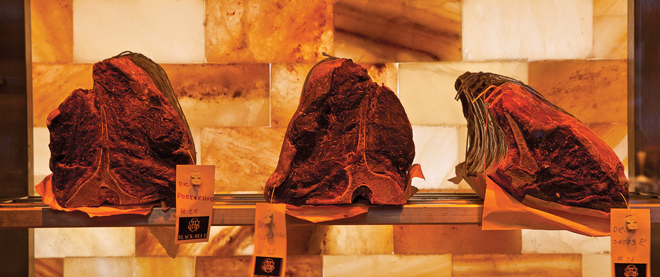Pink salt helps beefy hunks age well
Whether stowing meat in rooms of Himalayan bricks affects flavour is debatable
Photograph by Amanda Oster
Share

Steak houses seldom bring anything genuinely new to the table. So last summer when I found myself at Coast on Vancouver’s Alberni Street, chatting with proprietor Emad Yacoub, who was talking eagerly about his new steak house, I had to ask him what would be different about it.
“I’m going to do something nobody else has done here—an aging room made of pink Himalayan rock salt,” said Yacoub, CEO of Glowbal Restaurant Group.
And indeed, when Black + Blue opened in late October, with its aging room and a backlit, rear wall of pink salt bricks visible from the street, it was, so far as I know, a Canadian first. Pink salt-lined aging rooms started popping up stateside a few years ago, at places like David Burke’s Primehouse in Chicago and his Foxwoods casino restaurant, Prime. I first spotted one at the incomparable Victor Churchill butcher shop in Sydney, Australia, which had been added for their expansion from wholesale into retail in 2009. A couple of months ago, one of my Toronto butchers, Marlon Pather, relaunched his Yonge Street shop (formerly the Butchers) as Marlon’s and now he, too, has a pink salt wall.
The phenomenon bears examination. The salt is sourced from Pakistan, from ancient mines some claim were discovered by Alexander the Great. This gives the salt a certain mystique. The fact that it is pink and semi-translucent like onyx helps command a price of about $18 a brick. But it ultimately acts like any other salt, and the theory behind its use in aging rooms is simple. When dry-aging (as opposed to wet-aging, in a sealed plastic bag), moisture evaporates from the beef, helping to concentrate the flavour of the meat. If you use salt as a surface in the aging locker, it will absorb some of that moisture.
“The circulating air in the fridge will draw out moisture anyway,” conceded Josh Wolfe, a corporate chef who helps oversee Black + Blue as well as Coast for Glowbal. “But something about having the salt there makes it really easy to manage moisture and temperature exactly the way we want it.”
The salt appears to help stabilize the atmosphere through insulation. Wolfe also claims that it leaves the air in the room smelling surprisingly clean and fresh (given what is happening in there), which suggests that salt absorbs ambient aromas in the same way that baking soda does in the fridge at home. But as for whether it has any detectable impact on the beef hanging nearby, Wolfe was decidedly reticent, and Pather is much the same.
“I’m still not 100 per cent sure that it does anything substantial in terms of flavour,” he allowed of his pink wall. He was, however, unequivocal on the subject of its marketing virtues. “It’s a cool concept, a great-looking gimmick, and kids who come in with their moms just love it,” he said. Steak houses are obviously onto the same thing—just with older kids packing their own credit cards.
So the good news is, no, you do not need to go out and buy crates of Himalayan salt bricks to build a custom walk-in of your own. There is a far better use for the stuff anyway: cooking with it. Marlon’s chief butcher Eric Davis gave me a couple of spare salt bricks with my steak one day and suggested I try seasoning the beef on the brick in my fridge and then, after heating the bricks on the barbecue, cooking the meat on them.
While I am all for seasoning living animals with salt (consider the great salt-marsh lamb of Bordeaux), I never add it to meat until the last possible moment, so I passed on the first suggestion. But I did try the second, and the resulting steak was, well, fine. Then I had an epiphany: why not perform the same trick with a skin-on fillet of a fatty, grill-friendly fish, like salmon? This time I preheated the bricks at 550° F in a convection oven for two hours, transferred them to my grill, slipped a lightly oiled salmon fillet skin-side down directly on top of them, and closed the lid. Ten minutes later the result was exceptional: moist fish, gently cooked with radiant heat. All the fat had been rendered and what was left of the skin was as thin and as crisp as the ultimate potato chip. It was the stuff of dreams, Japanese dreams. Try it.